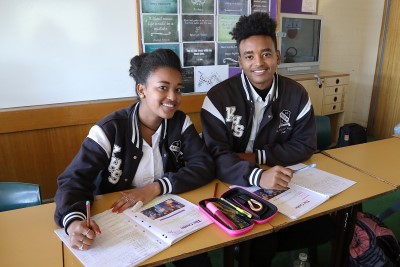Introduction

High school can sometimes be a challenging place. It is important to remember that there are many people and resources that can help you deal with these challenges.
By the end of this session you should:
-
identify and discuss challenges that you could face at high school
-
learn how to get help
-
recognise that you have the strength to deal with the challenges of high school.
Preparation and resources

To complete this session, you will need access to the following resources:
-
a computer
-
documents (found in the Activities section below)
-
6.1 – Discussing challenges (scenarios)
-
6.2 – Matrix for scenarios
-
6.3 – Cyberbullying.
-
Activities

Suggested activities for this session:
Open a copy of 6.1 – Discussing challenges (scenarios). You will be working in a small group and your teacher will assign your group some of the 8 scenarios from the worksheet.
Discuss your group’s scenarios, identify the issues and then talk about some solutions for the scenarios. Open a copy of 6.2 – Matrix for scenarios to record your group’s ideas.
Choose someone from your group to discuss your scenarios and solutions. This will allow the other students to think about all the scenarios and provide their own feedback.
School should be a safe place and no one has to put up with racism and bullying. There are many people in the school and community that can help you if you experience or witness racism or bullying.
You may have an opportunity to meet the school’s Anti-Racism Contact Officer (ARCO), who can help if you experience racism at school.
Racism and bullying can also include cyberbullying. Fortunately there are many ways to protect yourself from cyberbullying. Open a copy of 6.3 – Cyberbullying and use it as a reference. You may wish to print a copy and keep it in your diary.
Your teacher will read out a list of scenarios. Think about the best way to deal with each situation and discuss your ideas with the rest of the class.
Think of at least 1 person that you could go to for help if anything like this happens to you. Consider a trusted adult that you know will give you good advice.
Conclusion

Remember to write down the names of the different people that you can talk to if you need help to deal with racism, bullying or any other challenge at high school. This could be the ARCO, Year Adviser or EAL/D teacher.
Make a note in your diary about the meeting time for Session 7.
Remember to thank your teachers and other students that you worked with during the session.
Teaching notes
The Welcome Program sessions are designed to be teacher facilitated. Students should not be left to complete the activities without guidance.
This session provides students with the opportunity to discuss any challenges they may be facing and worrying about. It also reminds them about where to get help.
Aims
-
Students identify and discuss challenges they may be facing at high school.
-
Students learn how they can get help.
-
Students recognise that they have the strengths to help them deal with challenges.
-
Staff can identify areas of need and provide welfare support for students as required.
Before conducting this session, read all of the information in this resource and plan accordingly. You may choose to conduct some activities without using student computers and will therefore need to print out copies of worksheets for the students.
Invite the School Counsellor and Head Teacher Welfare to co-present and arrange a visit from the school’s Anti-Racism Contact Officer (ARCO).
Students will need access to the following resources:
-
computers
-
their NSW DoE student account to access Google Drive (test to see if students are able to log on to school computers and access the internet)
-
if students are unable to access Google Drive, you may need to print copies of all the worksheets
-
-
glue or tape.
Explain that in this session you will be discussing some of the challenges students often face at high school and how they can deal with them.
Have the students open a copy of 6.1 – Discussing challenges (scenarios). Students can be organised into small groups of 3 or 4, or the activity could be run as a class discussion. Nominate a scenario to start with or, if working in groups, assign 2 or 3 scenarios per group.
Ask students to identify issues and come up with possible solutions. Ask them to type their ideas into 6.2 – Matrix for scenarios.
After the groups have discussed the scenarios, ask them to choose someone to provide feedback to the class. This will ensure that all students are aware of various strategies and people to go to for help.
To see a completed scenario matrix, with suggested strategies, open a copy of 6.2 – Matrix for scenarios (possible solutions).
Discuss any other school resources or programs which could help students learn strategies or skills to deal with the challenges described in each scenario.
Explain to students that schools should be safe places and that no one has to put up with racism and bullying. There are many people in the school and community who can help.
Introduce students to the school’s Anti-Racism Contact Officer (ARCO) who can help them if they experience racism at school. Ask the ARCO to explain their role to the students.
Explain to the students that racism and bullying can include cyberbullying. Explain that there are ways they can protect themselves from cyberbullying. Have the students open a copy of 6.3 – Cyberbullying and read through it as a group, helping the students to understand both the definition and the strategies outlined in the document.
Thinking about the advice in the Cyberbullying information sheet, read the following list to the class and discuss strategies for dealing with each scenario:
-
Two of your friends have had an argument at school and are now sending rude text messages to each other after school.
-
Someone has set up a fake account in your name on a dating website.
-
A person you don’t know keeps writing racist and hurtful comments about you on your Facebook wall.
-
An unknown student has made a video threatening you not to come to school and posted it to YouTube.
-
Another student has started sending you text messages all the time. You think that they like you but you don’t feel the same way about them.
Ask students to name 1 person that they could go to for help if anything like this happens to them.
Remind students of the time and place for the next session. Explain that it will also be the last session of this part of the program.
Remind students that there are many people in the school who they can ask for help. For example, the ARCO, their Year Adviser or an EAL/D Teacher.
For more information, visit the NSW Department of Education’s The Welcome Program website.